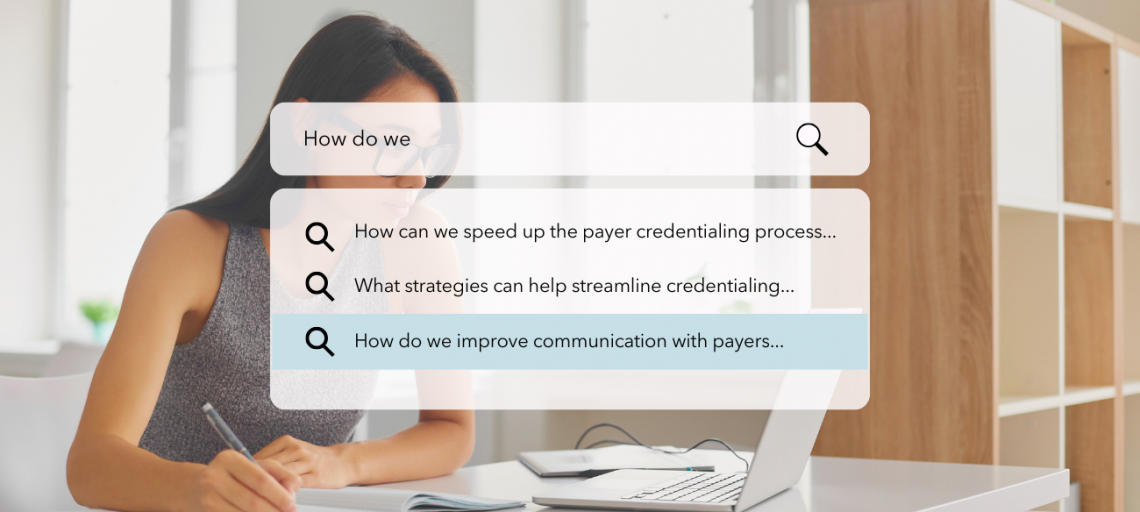
- July 8, 2025
- Credentialing
Ever wonder how to speed up the payer credentialing process? Or how to make provider document collection less of a hassle? You’re not alone. At Modio, we’ve been tracking the most common questions practice managers and credentialing teams are asking online, and our experts are here to weigh in. From credentialing shortcuts to best practices, we’re breaking down the top six questions that could help simplify your day-to-day. Let’s dive in.
1. How can we speed up the payer credentialing process, especially when dealing with extended turnaround times?
We understand how critical timely payer enrollment is to clients. Delays can impact revenue, provider satisfaction, and patient access. Accurate data, timely and consistent follow-ups, as well as patience and a positive attitude, can do wonders to improve your credentialing process. To help minimize turnaround times, especially when payers are slow to respond, we focus on a few key strategies:
- Clean, Complete Submissions: Using payer-specific portals/applications and having high attention to detail helps ensure applications are accurate and avoid delays from rework.
- Proactive Follow-Up: Assigning team members to follow up regularly keeps things moving and prevents applications from stalling.
- Early and Parallel Processing: When possible, and especially for known slow payers, build in lead time and start enrollment as early as possible, often in parallel with other steps like licensing.
- Tracking and Prioritization: Using tools like Modio’s OneView, including its process management tool “Tracking,” teams can stay on top of aging items and follow-up history so efforts are focused where they’re needed most.
- Payer Relationships: If/when possible, leverage direct contacts to help expedite the process if expedited credentialing is offered by the payer.
2. What strategies can help streamline the initial credentialing document collection from providers?
Step One: Identify exactly which documents are required for the specific type of credentialing you’re handling. Since each organization has its own unique set of requirements, getting a targeted list of only the necessary document types—rather than a generic, often overwhelming list—helps avoid unnecessary back-and-forth with providers. It also simplifies the process for them and speeds up the overall document collection timeline.
Step Two: Consider how you’re collecting those documents and how easy you’re making it for providers to submit them. For example, Modio’s OneView Onboarding tool streamlines this by allowing providers to upload documents directly to their profile from their phone or computer. It also ensures they’re only prompted to upload items that haven’t already been collected, making the process faster, easier, and more efficient for everyone involved.
Additionally, whenever possible, collect all required signature pages and documentation from the provider upfront. Going back and forth with a provider for missing items can lead to delays and longer processing times.
3. How do we improve communication with payers for real-time assistance?
Utilize available communication resources effectively. Most major payers offer secure provider portals for checking application status, submitting documentation, and messaging support teams directly. Build relationships with dedicated payer representatives for quicker insights into processing delays and faster resolutions. Maintain internal payer reference sheets with contact information, turnaround times, escalation paths, and portal logins to prevent bottlenecks and save time. Modern credentialing platforms support real-time data exchange through APIs, enabling seamless system communication and reducing redundancies. Consider platforms that integrate with payer systems to track communication timelines and include built-in messaging features or follow-up deadline alerts for streamlined workflow management.
4. What are the essential steps for starting a credentialing business, including certifications and systems?
Starting a provider credentialing business requires expertise in credentialing processes, payer enrollment, primary source verification, and CAQH management. Staying current with evolving industry standards is essential. While certification isn’t mandatory, credentials like CPCS (Certified Provider Credentialing Specialist) or CPMSM (Certified Professional Medical Services Management) boost credibility. Key requirements include business registration, professional liability insurance, and HIPAA-compliant systems for secure data handling. Essential tools are credentialing software, e-signature platforms, and payer portal access. Develop standardized procedures, build payer relationships, and establish ongoing monitoring for licenses and certifications. Target clients include medical practices, telehealth companies, healthcare systems, and billing companies needing credentialing support.
5. Which healthcare provider types require professional licenses, and are there exempt providers?
Professional licenses are legally required for most clinical providers who directly treat patients. This includes physicians, physician assistants, nurse practitioners, physical therapists, chiropractors, registered nurses, and other direct-care professionals. Providers must meet state requirements including education, exams, and background checks, with ongoing maintenance requiring annual fees, continuing education, and self-reporting disciplinary actions.
However, not all healthcare workers need professional licenses. Medical assistants are unlicensed and may only perform basic administrative, clerical and technical supportive services as permitted by law. Some behavioral health professionals, certain technicians, and administrative staff may require certifications or registrations instead of full professional licenses. Whether licensed or certified, verifying current credentials is crucial for credentialing processes. These credentials ensure safe patient care, support facility privileging decisions, and enable health plan enrollment for insurance reimbursements.
6. What are the best practices for verifying residency completion and determining whether to grant temporary privileges?
Verify residency completion through the AMA’s FREIDA database, which provides information on ACGME-accredited residency and fellowship programs for primary source verification. For temporary privileges, follow facility bylaws requiring verification of education, active medical license, and NPDB queries to identify high-risk providers. The full privilege application must remain actively in process during temporary privilege periods. Complete all verification steps promptly since temporary privileges are short-term solutions while full credentialing is finalized. Time-limited, non-renewable temporary privileges are generally not reportable to the NPDB, though no distinction is made between temporary and regular privileges for reporting purposes.
